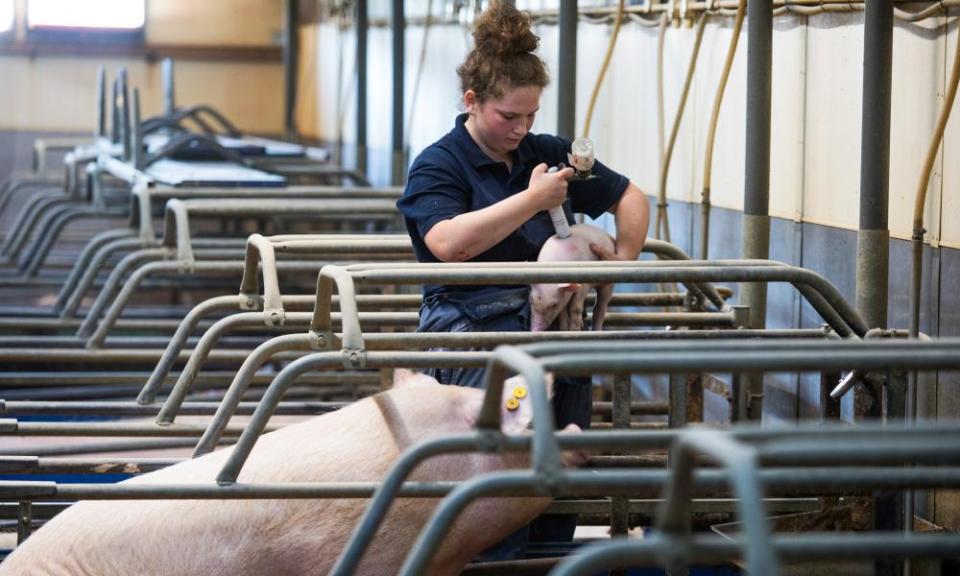Oxford animal-only antibiotic lab could prop up intensive farming, critics say

An initiative to develop bespoke antibiotics for livestock has raised fears that it could be a “techno-fix” for more intensive farming.
Mixed reactions have followed news that Ineos, a global petrochemical manufacturer, has donated £100m to establish the Ineos Oxford University Institute (IOI) for antimicrobial research.
The institute said it would focus on designing novel antimicrobials solely for animals because the majority of global antibiotic consumption by volume was in agriculture, and antibiotic use in animals was contributing significantly to their lessening effectiveness in humans.
“[There is] a shocking overlap between some classes of antibiotics used in animals and in humans, so we need to separate the two. Examples include penicillin and the tetracycline-type antibiotics,” Christopher Schofield, IOI project lead and head of organic chemistry at the University of Oxford, said.
“The good thing is that [agriculture] feeds us. The bad thing is that resistance develops in both humans and animals – and yes, the evidence is that, globally, most antibiotics are used in agriculture – probably over 70% by mass, so we really need to address that.”
Another overlap example is ampicillin, an antibiotic used around world as a livestock growth promoter, according to Timothy Walsh, IOI biology lead and Oxford University professor of medical microbiology.
“Thousands of tons [of ampicillin] are used in Asia and Africa, and yet it is an antibiotic advocated by the WHO to treat neonatal sepsis [an infection that can kill new-born babies],” he said. Recent research had found that in low- and middle-income countries, 90% of the gram-negative bacteria that cause sepsis are now resistant to ampicillin, he said. “That’s bonkers. It cannot go on.”
Walsh said the IOI’s aim was to produce new animal-only antibiotics within the next five to 10 years. The antibiotics, he said, would be “better for animal welfare and will safeguard human antibiotics”.
The new class of animal-only antibiotics would, however, change current policies aimed at reducing and restricting use of antibiotics in agriculture, he agreed.
“It should be the case that we can use antibiotics for animals as needed and antibiotics for humans as needed. We really need to think about that farmer in Laos who has 2,000 chickens who is using an antibiotic that works for his chickens; they get bigger and healthier. You can’t just take the antibiotics away without offering the farmer an alternative.”
But Cóilín Nunan, scientific adviser to the Alliance to Save Our Antibiotics, said he was “not convinced” that the best approach was to focus on developing new animal-only antibiotics.
Related: How can you support farmers who are using fewer antibiotics?
One of the risks, Nunan said, would be that it might “simply enable further intensification”. Scientific evidence, he added, already showed “that intensive farms can be breeding grounds for new bacterial superbugs and new types of viruses with pandemic potential in humans”.
Peter Stevenson, an animal welfare lawyer who works with the charity Compassion in World Farming, went further, calling the possibility of animal-only antibiotics a “techno-fix designed to tackle the symptoms of industrial animal agriculture rather than recognising the need for transformative change”.
Maria Lettini, executive director of Fairr, which describes itself as a $28tn (£20tn) investor network that aims to encourage the world’s largest food companies to move away from an overreliance on animal proteins, said: “The jury is not yet out as to whether animal-only antibiotics will successfully mitigate the risk of resistance in humans.”
Asked if he was concerned that the development of animal-only antibiotics might lead to more intensive farming, Tom Crotty, Ineos corporate affairs director, said it was not a risk he had considered.
Walsh and Schofield said they did not expect their work to support larger, more intensive farming and would advocate against such a development. “Less intensive is definitely better from an infection perspective,” said Schofield.
Sign up for the Animals farmed monthly update to get a roundup of the best farming and food stories across the world and keep up with our investigations. You can send us your stories and thoughts at animalsfarmed@theguardian.com

 Yahoo Finance
Yahoo Finance 